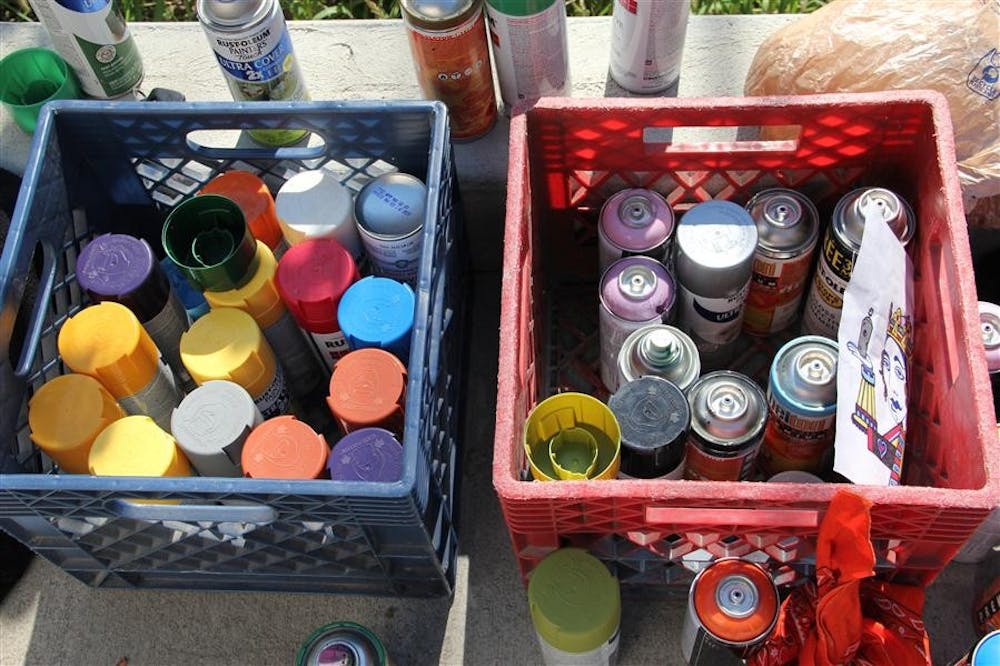The transition from daydreaming while sketching bubble letters in a
Mead notebook to holding your breath as you spray paint lines across a
rust-encrusted freight car — keeping one eye open for the authorities —
would be, for most people, improbable.
But for Rafael Cronin, it was a logical progression that began in 2005 when he visited family in Spain.
At
the time, graffiti was en vogue, as Cronin remembers, and what he saw
in the exploits of the Spanish graffiti artists was a chance to combine
his love of art and hip-hop.
Before returning stateside, he bought a set of Montana markers — a brand synonymous with tagging.
His
paint markers turned into spray cans, which led to even more spray
cans. Wooden boards found in his parents’ shed became walls. Walls
became trains.
As a quiet Bloomington High School South student, Cronin found his voice
in the loud, colorful scribbles he left in his wake. He savored the
indirect publicity.
“The element of anonymity in graffiti is
something that’s very seductive for many people that don’t want to draw
too much direct attention to themselves,” he says.
He worked alone at first, developing his own style on the walls of bathrooms and the sides of trains.
Eventually,
his work, and a particular orange Montana marker from Spain, drew the
attention of a local tagging crew, which asked him to join up.
Cronin looks at the invitation as a chance to push his art in new directions.
Time
spent with other graffiti writers from crews with names like “USC”
(Used Crew), “SAL” (Suspects At Large) and “ACT” (Always Causing
Trouble) immersed Cronin in Bloomington’s graffiti subculture.
With his new lifestyle came a new worldview, complete with a sharper set of eyes.
“I became more fluent with the craft of graffiti and aware of every mark on the walls,” he says.
At
his peak, Cronin was no stranger to doing large, colorful pieces every
few weeks, some of which were photographed on freight cars as far west
as California. Bombs (lettering outlines and marker tags) were easier to
get away with.
These days, Cronin is a BFA student who spreads paint on canvas, not walls.
“There just isn’t any danger,” Cronin says. “No time constraints, either. I can revisit my work and make edits now.”
The decision to drop aerosol art was made neither deliberately nor overnight.
Bloomington’s graffiti scene has changed a lot in recent
years. Many of the local crews have all but disbanded Cronin says, and
Bloomington Police Department photographs and data seem to confirm
this.
With time, the hunger simply faded. He hasn’t put up so much as a tag in seven months.
After
years of adrenaline-soaked nights, another cousin’s influence drew
Cronin toward a new, safer medium. Not only was the safety of the studio
alluring, the hours were better, and, for the first time, he could
publicly claim his work.
It’s no secret that the ego is a fundamental motivator for graffiti artists.
“The same method as a dog who’s gonna piss anywhere he can to claim territory applies to graffiti,” Cronin says.
One
of the fundamental goals of graffiti is to conquer as much space as
possible to get your name out there, even if those hours spent behind a
spray can might be removed the next day. To him, the ephemeral nature of
graffiti only enhances the art form.
Though most of his own pieces have been covered or removed, Cronin can’t
forget his roots. And after months away from the streets, he says he’s
still conflicted about the effects of his wayward artistic exploits.
“I
don’t know if it’s dangerous (for the community), but I’m also not
gonna be on the stance that it’s morally correct,” Cronin says. “I mean,
I’m torn. For example, there are people who will download music
illegally and still have a guilty conscience while doing it, but in the
end it’s easier to do it. It’s a better solution than to go out and pay
for it.”
“That same thing applies to graffiti and it’s exciting to see your work
out there in the public space, and it’s exciting to see the whole world
as your canvas. It’s one of the most exhilarating feelings you can have
as an artist.”
Cultural perceptions have always been divided on graffiti’s artistic and
moral merits. Where some see aesthetic value, others see property
damage and vandalism.
“When you see a place that’s an eyesore and
you have faith in your art to reshape the aesthetic of that place —
that’s my excuse,” Cronin says. “I see a big metal freight coming
attached to a train. I’m thinking, ‘This is a box that’s been rusted
over for years, and it’s really not that pretty.’ So adding lilac to it,
a little red, white and blue, a little composition and form, brings new
life to it.”
The fine art of tagging

Get stories like this in your inbox
Subscribe





